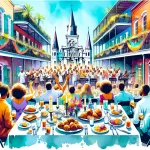New Orleans is the undisputed capital of Mardi Gras, a lively celebration that has captivated the world with its rich traditions, colorful pageantry, and infectious energy. This annual festival, rooted in the city’s diverse cultural heritage, is a time of revelry, indulgence, and community spirit that draws visitors from far and wide.
In This Article
TL;DR
- Mardi Gras marks the culmination of the Carnival season, a period of feasting and merrymaking before the observance of Lent.
- Essential traditions include elaborate parades, extravagant balls, the selection of royalty, and the exchange of coveted throws and trinkets.
- Key considerations for attending include timing your visit, securing accommodations, navigating the city during festivities, and experiencing the unique culinary offerings.
Historical Context of Mardi Gras
The origins of Mardi Gras can be traced back to ancient pagan celebrations marking the arrival of spring, which were later adopted and adapted by the Catholic Church. In New Orleans, the festival’s roots date back to 1699 when French-Canadian explorer Jean Baptiste Le Moyne Sieur de Bienville landed on the Mississippi River’s banks and named the site “Pointe du Mardi Gras.
The city’s French and Spanish colonial histories have profoundly influenced the celebration’s traditions. In the early 1740s, Louisiana’s governor, the Marquis de Vaudreuil, established elegant society balls that became the model for the modern Mardi Gras balls. Key figures like the Mistick Krewe of Comus, who introduced the first parade with floats in 1857, and the Krewe of Rex, who established the iconic colors of purple, green, and gold in 1872, have left an indelible mark on the festival’s evolution.
Core Traditions of Mardi Gras
At the heart of Mardi Gras are the vibrant parades that wind through the streets of New Orleans. These extravagant processions feature elaborate floats, marching bands, and revelers tossing coveted throws, such as beads, cups, and doubloons, to the crowds lining the route.
The Mardi Gras balls are another cherished tradition, where krewes (social clubs) select their royalty, including kings, queens, and courts, to preside over the festivities. These lavish events are steeped in pageantry, with attendees donning opulent costumes and masks.
Krewes themselves play a vital role in the Mardi Gras celebrations, organizing parades, balls, and other events. These organizations, often shrouded in secrecy, have been instrumental in preserving and perpetuating the festival’s traditions for generations.
Symbols and Colors of Mardi Gras
The colors purple, green, and gold, established by the Krewe of Rex in 1872, have become synonymous with Mardi Gras. Purple represents justice, green symbolizes faith, and gold signifies power – a nod to the festival’s regal roots.
Masks and costumes are integral to the Mardi Gras experience, allowing revelers to embrace anonymity and let loose during the celebrations. The iconic King Cake, a ring-shaped pastry with a small plastic baby figurine baked inside, is another symbol of the festival, with the person finding the baby being tasked with hosting the next party or providing the next King Cake.
Planning Your Mardi Gras Experience
The best time to visit New Orleans for Mardi Gras is typically the week leading up to Fat Tuesday, when the city is abuzz with parades and festivities. However, for a more relaxed experience, consider visiting during the earlier weeks of the Carnival season, when smaller neighborhood parades take place.
Accommodations in the city fill up quickly, so it’s advisable to book well in advance. Consider staying in the French Quarter or nearby neighborhoods for easy access to the parades and events. Utilizing public transportation or ride-sharing services is recommended, as parking can be challenging during the peak of the celebrations.
Participating in Mardi Gras
Spectators can enjoy the parades from designated viewing areas along the routes, while more adventurous revelers can join in the festivities by participating in the parades or attending balls hosted by krewes. It’s essential to familiarize yourself with etiquette and safety guidelines, such as respecting parade barriers and avoiding throwing objects back at floats.
For a more immersive experience, consider volunteering with a krewe or joining one as a member. Many organizations offer opportunities to get involved in the planning and execution of their events, providing a unique behind-the-scenes perspective on the festival’s traditions.
Mardi Gras Cuisine
No Mardi Gras experience would be complete without indulging in the city’s rich culinary offerings. Traditional dishes like gumbo, jambalaya, and po’boy sandwiches are must-tries, reflecting the diverse cultural influences that have shaped New Orleans’ cuisine.
During the festival, many restaurants offer special Mardi Gras menus or themed dishes, so be sure to make reservations in advance. Street food vendors also abound, offering a taste of local favorites like beignets, pralines, and muffulettas.
Beyond the Festival: Year-Round Mardi Gras Culture
While the annual Mardi Gras celebration is the pinnacle of the city’s festivities, New Orleans embraces its Carnival culture year-round. Museums like the Mardi Gras Museum and the Backstreet Cultural Museum offer insights into the festival’s history and traditions, with exhibits showcasing elaborate costumes, floats, and memorabilia.
Educational programs and tours explore the cultural significance of Mardi Gras, shedding light on its roots, symbolism, and the role of krewes in preserving these traditions. Community events and smaller parades throughout the year provide opportunities for locals and visitors alike to experience the spirit of Mardi Gras beyond the main festival season.






